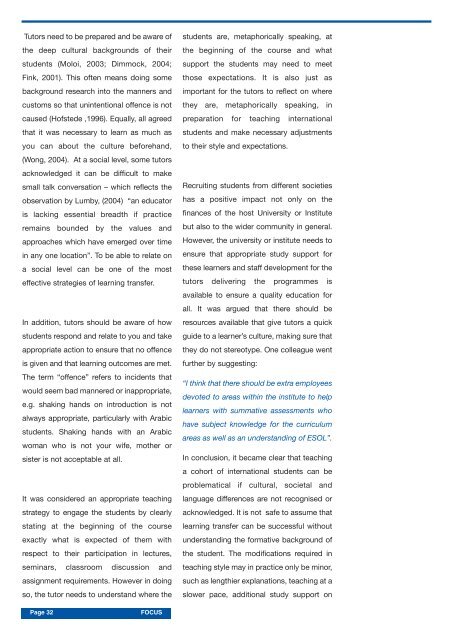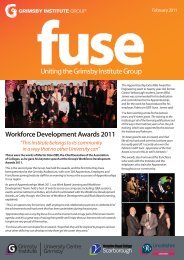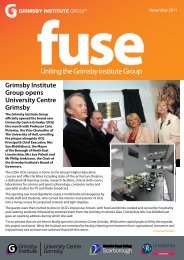Journal of Research & Scholarly Output 2006 - Grimsby Institute of ...
Journal of Research & Scholarly Output 2006 - Grimsby Institute of ...
Journal of Research & Scholarly Output 2006 - Grimsby Institute of ...
Create successful ePaper yourself
Turn your PDF publications into a flip-book with our unique Google optimized e-Paper software.
Tutors need to be prepared and be aware <strong>of</strong><br />
the deep cultural backgrounds <strong>of</strong> their<br />
students (Moloi, 2003; Dimmock, 2004;<br />
Fink, 2001). This <strong>of</strong>ten means doing some<br />
background research into the manners and<br />
customs so that unintentional <strong>of</strong>fence is not<br />
caused (H<strong>of</strong>stede ,1996). Equally, all agreed<br />
that it was necessary to learn as much as<br />
you can about the culture beforehand,<br />
(Wong, 2004). At a social level, some tutors<br />
acknowledged it can be difficult to make<br />
small talk conversation – which reflects the<br />
observation by Lumby, (2004) “an educator<br />
is lacking essential breadth if practice<br />
remains bounded by the values and<br />
approaches which have emerged over time<br />
in any one location”. To be able to relate on<br />
a social level can be one <strong>of</strong> the most<br />
effective strategies <strong>of</strong> learning transfer.<br />
In addition, tutors should be aware <strong>of</strong> how<br />
students respond and relate to you and take<br />
appropriate action to ensure that no <strong>of</strong>fence<br />
is given and that learning outcomes are met.<br />
The term “<strong>of</strong>fence” refers to incidents that<br />
would seem bad mannered or inappropriate,<br />
e.g. shaking hands on introduction is not<br />
always appropriate, particularly with Arabic<br />
students. Shaking hands with an Arabic<br />
woman who is not your wife, mother or<br />
sister is not acceptable at all.<br />
It was considered an appropriate teaching<br />
strategy to engage the students by clearly<br />
stating at the beginning <strong>of</strong> the course<br />
exactly what is expected <strong>of</strong> them with<br />
respect to their participation in lectures,<br />
seminars, classroom discussion and<br />
assignment requirements. However in doing<br />
so, the tutor needs to understand where the<br />
students are, metaphorically speaking, at<br />
the beginning <strong>of</strong> the course and what<br />
support the students may need to meet<br />
those expectations. It is also just as<br />
important for the tutors to reflect on where<br />
they are, metaphorically speaking, in<br />
preparation for teaching international<br />
students and make necessary adjustments<br />
to their style and expectations.<br />
Recruiting students from different societies<br />
has a positive impact not only on the<br />
finances <strong>of</strong> the host University or <strong>Institute</strong><br />
but also to the wider community in general.<br />
However, the university or institute needs to<br />
ensure that appropriate study support for<br />
these learners and staff development for the<br />
tutors delivering the programmes is<br />
available to ensure a quality education for<br />
all. It was argued that there should be<br />
resources available that give tutors a quick<br />
guide to a learner’s culture, making sure that<br />
they do not stereotype. One colleague went<br />
further by suggesting:<br />
“I think that there should be extra employees<br />
devoted to areas within the institute to help<br />
learners with summative assessments who<br />
have subject knowledge for the curriculum<br />
areas as well as an understanding <strong>of</strong> ESOL”.<br />
In conclusion, it became clear that teaching<br />
a cohort <strong>of</strong> international students can be<br />
problematical if cultural, societal and<br />
language differences are not recognised or<br />
acknowledged. It is not safe to assume that<br />
learning transfer can be successful without<br />
understanding the formative background <strong>of</strong><br />
the student. The modifications required in<br />
teaching style may in practice only be minor,<br />
such as lengthier explanations, teaching at a<br />
slower pace, additional study support on<br />
Page 32<br />
FOCUS

















